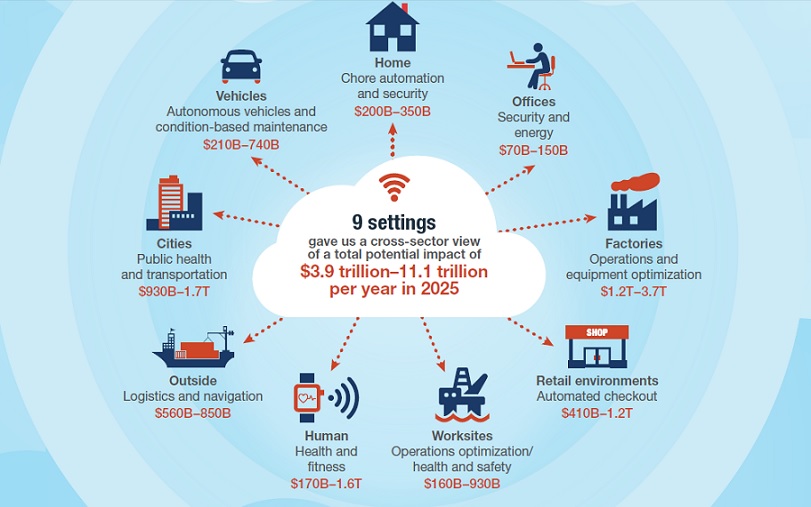The McKinsey Global Institute has released a 142-page report – The Internet of Things: Mapping the Value Beyond the Hype – which has basically summarised that the world was perhaps “underestimating the potential economic impact of the Internet of Things (IoT).”
The report, a copy of which was made available to this Website, said by 2025, based on a range of IoT adoption rates, economic and demographic trends, and the likely evolution of technology over the next ten years, the economic impact of IoT applications could be from the present-day US $3.9 trillion to US $11.1 trillion per year.
McKinsey explained it had conducted the research to “examine in detail how the IoT can create value”. In the process, the research team had uncovered “novel findings” about how that value can be captured by companies, people, and economies.
The McKinsey Global Institute, in collaboration with McKinsey’s Telecommunications, Media, and High Technology Practice and the McKinsey Business Technology Office, had analysed over 150 IoT user cases across the global economy. Using detailed bottom-up economic
modeling, the report estimated the economic impact of these applications by the potential benefits they could generate, including productivity improvements, time savings, and improved asset utilisation, as well as an approximate economic value for reduced disease, accidents, and deaths. These estimates of potential value were not equivalent to industry revenue or GDP, because they included value captured by customers and consumers.
An important contribution of this research was to demonstrate the importance of
analysing the applications of the IoT in the context of settings—the physical
environments in which these systems were deployed, such as homes, offices, and factories.
A key insight from analyzing the benefits of IoT applications within settings was the critical
contribution made by interoperability among IoT systems. On an average, said the report, interoperability was necessary to create 40 percent of the potential value that could be generated by the IoT in various settings.
 According to McKinsey, there were six reasons why the world may be “underhyping the IoT”. These included the use of less data, limited focus only on Industries and neglecting the B2B opportunity.
According to McKinsey, there were six reasons why the world may be “underhyping the IoT”. These included the use of less data, limited focus only on Industries and neglecting the B2B opportunity.
McKinsey found in its analysis that not all the data that sensors were cranking out 24/7 was being analysed. In some cases, McKinsey said, end-users may be using only 1 percent of all the data out there. Even then, the data was used only for simple things such as anomaly detection and control systems.
Further, rather than focusing on verticals and industries, McKinsey took a detailed look at the sweeping changes taking place in nine physical “settings” where the IoT was actually to be deployed — home, retail, office, factories, work sites (mining, oil and gas, construction), vehicles, human (health and wellness), outside (logistics and navigation) and cities. Of that $11 trillion in economic value, four of the nine settings topped out at more than $1 trillion in projected economic value — factories ($3.7 trillion), cities ($1.7 trillion), health and fitness ($1.6 trillion) and retail ($1.2 trillion).
McKinsey also said the business-to-business market opportunity could be more than two times the size of the business-to-consumer opportunity. One big example cited by McKinsey is the ability of work sites to take better advantage of the IoT.
According to the report, approximately 40 percent of the total economic value of the IoT was driven by the ability of all the physical devices to talk to one another via computers.
– Advertising Message –
